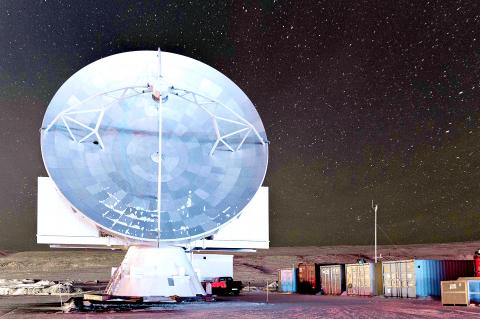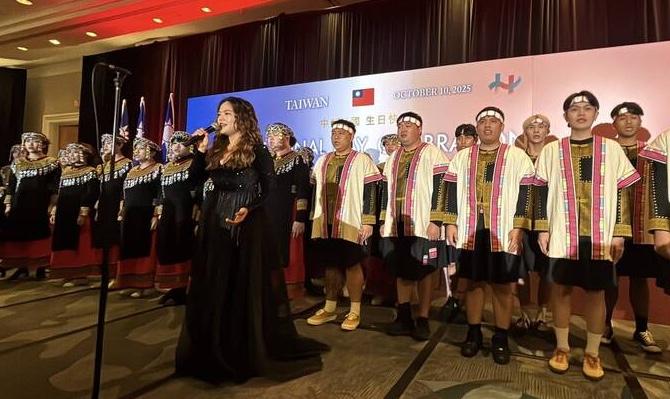A team of scientists, including researchers from Academia Sinica’s Institute of Astronomy and Astrophysics, have set up a new radio telescope in Greenland and look forward to capturing the world’s first image of a black hole, Taiwanese team members said yesterday.
The institute’s researchers last year worked with colleagues from the Harvard-Smithsonian Center for Astrophysics to install the Greenland Telescope (GLT) at the US’ Thule Air Base, team member Chen Ming-tang (陳明堂) told a news conference in Taipei.
The GLT is the only astronomical observation station in the Arctic Circle, where the drier and clearer weather is conducive for observation, although the minus-30°C temperatures presents many challenges, Chen said.

Photo courtesy of Academia Sinica
It is part of the Event Horizon Telescope project, which was designed to capture the image of a black hole by connecting with other telescopes worldwide, including the Submillimeter Array and the James Clerk Maxwell Telescope in Hawaii, and the Atacama Large Millimeter Array in Chile, he said.
Obtaining an image of a black hole would be a significant breakthrough for science, as belief in the existence of black holes rests largely on theoretical inferences and indirect evidence, he said.
More knowledge about black holes would help scientists test Albert Einstein’s theory of general relativity, he added.
Two black holes have been targeted, one in the Messier 87 (M87) galaxy and the other in the center of the Milky Way, where our solar system is located, said Paul Ho (賀曾樸), director-general of the East Asian Observatory in Hawaii and a distinguished research fellow at the institute.
The black hole in M87 is more likely to be observed, given it is more massive, and its rotation slower, Ho said.
The GLT contains a 12m-wide radio antenna originally built as a prototype for the array in Chile, which was granted to the institute by the US National Science Foundation in 2011, Chen said.
In five years, they plan to transport the GLT to the foundation-supported Summit Station where the observational conditions are better, Chen added.
The station is atop a 3,200m peak on the Greenland ice sheet.
The National Chungshan Institute of Science and Technology (NCIST), which has worked with the GLT team since 2011, helped with the engineering needed to adapt the antenna to Arctic weather conditions, Chungshan vice president Ko Ping-ya (葛平亞) told the news conference.
The NCIST team would face further challenges with moving the GLT, since the Summit Station has limited daily provisions, unlike what is available on the air base, Ko said.

The Taipei Mass Rapid Transit (MRT) Wanda-Zhonghe Line is 81.7 percent complete, with public opening targeted for the end of 2027, New Taipei City Mayor Hou You-yi (侯友宜) said today. Surrounding roads are to be open to the public by the end of next year, Hou said during an inspection of construction progress. The 9.5km line, featuring nine underground stations and one depot, is expected to connect Chiang Kai-shek Memorial Hall Station to Chukuang Station in New Taipei City’s Jhonghe District (中和). All 18 tunnels for the line are complete, while the main structures of the stations and depot are mostly finished, he

Taipei is to implement widespread road closures around Taipei 101 on Friday to make way for large crowds during the Double Ten National Day celebration, the Taipei Department of Transportation said. A four-minute fireworks display is to be launched from the skyscraper, along with a performance by 500 drones flying in formation above the nearby Nanshan A21 site, starting at 10pm. Vehicle restrictions would occur in phases, they said. From 5pm to 9pm, inner lanes of Songshou Road between Taipei City Hall and Taipei 101 are to be closed, with only the outer lanes remaining open. Between 9pm and 9:40pm, the section is

The first global hotel Keys Selection by the Michelin Guide includes four hotels in Taiwan, Michelin announced yesterday. All four received the “Michelin One Key,” indicating guests are to experience a “very special stay” at any of the locations as the establishments are “a true gem with personality. Service always goes the extra mile, and the hotel provides much more than others in its price range.” Of the four hotels, three are located in Taipei and one in Taichung. In Taipei, the One Key accolades were awarded to the Capella Taipei, Kimpton Da An Taipei and Mandarin Oriental Taipei. Capella Taipei was described by

The Taipei Economic and Cultural Office in Vancouver, Canada, on Saturday hosted a reception to celebrate Double Ten National Day. Conservative Canadian lawmaker Marc Dalton called Taiwan a “beacon of courage and resilience in the face of rising authoritarianism,” according to a post on the Taiwan in Vancouver Facebook page. Also in attendance were fellow conservative caucus members Tako Van Popta and Chak Au, who said that Taiwan plays an “indispensable role” in ensuring global peace, prosperity and stability due to its strategic position in the Indo-Pacific region, it said. Canadian lawmaker Michael Cooper also recorded a message wishing Taiwan a